By: Anna Bella D’Amico
Ever since October 1st, South Carolina has been in a state of emergency due to the impact of Hurricane Joaquin. The coastal cities have been buried under several feet of water. The majority of the rain has ended, yet the flooding has remained. Already at least fifteen people have died, and the death count is slowly rising.
On Wednesday, October 7, 2015, Columbia citizens were told to evacuate their homes due to a dam breakage. Millions of gallons of water was expected to pour into the city. “Move to higher ground. Act quickly to protect your life,” said The National Weather Service in an alert sent out to the area. University of South Carolina has now been without fresh drinking water and plumbing for several days, while an effort is being made to supply them and other affected areas in the same conditions. Columbia has also issued a Boil-Water warning to all 375,000 of its water consumers, informing the residents not to drink any non-bottled water without boiling it for at least a minute and that an ice produced during the flood should not be used unless boiled. Columbia Mayor Steve Benjamin, said “… I anticipate that the damage will probably be in the billions of dollars … Some people lives as they know them will never be the same.” Columbia has received a record 24 hour rainfall.
President Obama has issued a disaster declaration for the state of South Carolina, ordering it to receive federal monetary support and resources.
Many people have been rescued off their roof by helicopters patrolling the areas. Water patrol has also rescued people stranded in their cars and flooded homes. People are coming back to finding their houses looted. Vandals are breaking into deserted homes are stealing everything including, TVs and jewelry, among other things. Many highways have been detoured and others have been granted partial service. Officials think it is going to take weeks or even months to asses the stability of all the roads and highways. South Carolina Governor Nikki Haley has reported there to be 175 water rescues and over 800 people in temporary housing. Nearly 30,000 people lost power during the bulk of the storm, and many are still without power. Residents are forced to rid their homes of all flood damaged furniture; the overall cost of possessions lost is in the millions.
There was a very serious potential of more dams breaking, and even more money being expensed for repairs and clean up. Eleven of the dams have broke, while another thirty-five are being monitored. National Guard members are helping with sandbagging operations and other efforts to help reduce the damage and prevent possible future dam breakage. Officials are conducting controlled breakage, which is the delayal of the breaking of the dam in order to allow citizens time to evacuate, as well as the limitation of damage and amounts of water from the breach.
The American Red Cross is pleading for any and everybody to take part in the rescue operations. Supplies are very much appreciated, as they are taking everything they can get. Columbia is in desperation of safe water. The entire state is in need for as much monetary support they can get. Gov. Haley refuses to release an estimated damage number, but says it is “Disgusting.” There are many shelters set up around the state, providing support.
As the week progressed, major highways are being opened and some of the clean up process has begun. Flood water is starting to recede, however, the environment is still unstable. Recovery is expected to take at least a couple of weeks, if not months. Nonetheless, the weather conditions are starting to turn around and the future look is looking brighter for South Carolina.


